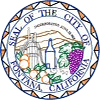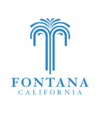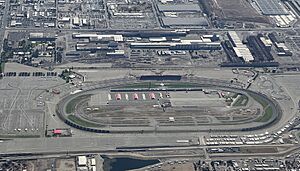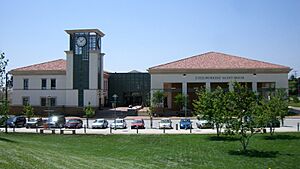Fontana, California facts for kids
Quick facts for kids
Fontana, California
|
|||||
|---|---|---|---|---|---|
|
Counterclockwise: Cucamonga Peak in the San Gabriel Mountains; Fontana Center Stage; aerial view of Fontana; Lewis Library
|
|||||
|
|||||
| Motto(s):
"City of Action"
|
|||||
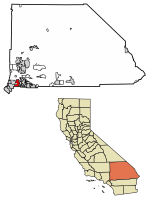
Location of Fontana in San Bernardino County, California
|
|||||
| Country | United States | ||||
| State | California | ||||
| County | San Bernardino | ||||
| Founded | 1913 | ||||
| Incorporated | June 25, 1952 | ||||
| Named for | Italian for fountain or water source; in reference to the Santa Ana River | ||||
| Government | |||||
| • Type | Council-Manager | ||||
| Area | |||||
| • Total | 52.04 sq mi (135.72 km2) | ||||
| • Land | 52.04 sq mi (135.72 km2) | ||||
| • Water | 0.00 sq mi (0.00 km2) 3% | ||||
| Elevation | 1,237 ft (377 m) | ||||
| Population
(2020)
|
|||||
| • Total | 212,704 | ||||
| • Rank | 2nd in San Bernardino County 20th in California 109th in the United States |
||||
| • Density | 4,838.47/sq mi (1,868.16/km2) | ||||
| Time zone | UTC−7 (PST) | ||||
| • Summer (DST) | PDT | ||||
| ZIP codes |
92331, 92334-92337
|
||||
| Area codes | 909, 840 | ||||
| FIPS code | 06-24680 | ||||
| GNIS feature IDs | 1652711, 2410517 | ||||
Fontana is a city in San Bernardino County, California, United States. It was started by Azariel Blanchard Miller in 1913. For a long time, it was mostly a farming area.
During World War II, a big change happened. A man named Henry J. Kaiser built a large steel factory there. This factory helped the city grow a lot. Today, Fontana is a major center for the trucking industry. Important highways like Interstate 10, State Route 210, and Interstate 15 pass through the city. Fontana is about 46 miles (74 km) east of Los Angeles.
In 2020, the city had a population of 208,393 people. This makes Fontana the second-biggest city in San Bernardino County. It is also the 20th largest city in all of California.
Contents
History of Fontana
Fontana was founded in 1913 by Azariel Blanchard Miller. In its early years, it was a farming town. People grew citrus fruits and grapes, and raised chickens. It was located along the famous U.S. Route 66, which is now called Foothill Boulevard.
Fontana's Growth During World War II
Fontana changed a lot during World War II. Henry J. Kaiser built one of the only two steel mills west of the Mississippi River near the city. To help the factory workers stay healthy, Kaiser also built the Fontana Kaiser Permanente medical center. This is now one of the biggest healthcare groups in the United States.
Drag Racing History
In the 1950s and 1960s, Fontana was famous for its drag racing strip. It was a popular spot for the NHRA races. This old track was known as Fontana International Dragway. Even though the original track is gone, a new drag strip opened in 2006. It was built by the owners of NASCAR's new Auto Club Speedway. This brought drag racing back to Fontana.
Classic Car Museum
There was once an automobile museum called Ro-Val's on Foothill Boulevard. It showed off many classic cars from the 1920s and 1930s. One car even belonged to the famous actor Fatty Arbuckle. When the museum closed, the cars were sold to Bill Harrah. He was a casino owner and car collector who displayed them in his own museum.
Fontana's Population Boom
In 2000, Fontana had about 128,929 people. By 2013, the population grew to over 200,000. This fast growth happened because many new homes were built in the northern part of the city. Also, Fontana worked hard to add nearby areas that were not part of any city yet.
Geography and Landscape
Most of Fontana is built on a gentle slope. This land was formed by Lytle Creek over many thousands of years. The city is also near two mountain ranges: the San Gabriel Mountains to the north and the Jurupa Mountains to the south.
Mountains and Fault Lines
The San Gabriel Mountains are very old. You can see Cucamonga Peak, which is 8,859 feet (2,700 meters) tall, from Fontana. There's also a fault line called the Cucamonga Fault Zone that runs through the northern part of the city. This fault can cause earthquakes.
City's Elevation
The official elevation of Fontana, measured downtown, is 1,237 feet (377 meters). However, the highest point in the city is about 2,600 feet (792 meters) in the Hunter's Ridge area. The lowest point is about 840 feet (256 meters) in the southwestern part of the city. This difference is because the land slopes downwards from the mountains.
Fontana's Climate
Fontana often experiences strong, hot, and dry winds called Santa Ana winds. These winds blow through the nearby Cajon Pass from the Mojave Desert. Summers in Fontana can be very hot, often going above 100 degrees Fahrenheit (38 degrees Celsius).
| Climate data for Fontana, California | |||||||||||||
|---|---|---|---|---|---|---|---|---|---|---|---|---|---|
| Month | Jan | Feb | Mar | Apr | May | Jun | Jul | Aug | Sep | Oct | Nov | Dec | Year |
| Record high °F (°C) | 93 (33.9) |
92 (33.3) |
97 (36.1) |
102 (38.9) |
112 (44.4) |
111 (43.9) |
114 (45.6) |
111 (43.9) |
117 (47.2) |
108 (42.2) |
96 (35.6) |
93 (33.9) |
117 (47.2) |
| Mean daily maximum °F (°C) | 69 (20) |
70 (21.1) |
71 (21.7) |
77 (24.4) |
81 (26.7) |
89 (31.1) |
95 (35) |
96 (35) |
92 (32.8) |
83 (28.3) |
74 (23.3) |
70 (20.6) |
81 (27.4) |
| Mean daily minimum °F (°C) | 46 (7.2) |
47 (8.3) |
48 (8.3) |
50 (9.4) |
53 (11.7) |
58 (13.9) |
63 (16.7) |
64 (17.2) |
63 (16.7) |
57 (13.3) |
50 (9.4) |
46 (6.7) |
53.8 (11.87) |
| Record low °F (°C) | 22 (−5.6) |
28 (−2.2) |
30 (−1.1) |
30 (−1.1) |
35 (1.7) |
42 (5.6) |
48 (8.9) |
48 (8.9) |
44 (6.7) |
33 (0.6) |
28 (−2.2) |
23 (−5) |
22 (−5.6) |
| Average precipitation inches (cm) | 3.50 (8.89) |
3.42 (8.68) |
3.49 (8.86) |
0.63 (1.60) |
0.19 (0.48) |
0.01 (0.02) |
0.00 (0) |
0.11 (0.27) |
0.26 (0.66) |
0.27 (0.68) |
1.26 (3.20) |
1.63 (4.14) |
14.77 (37.51) |
| Source: weather.com | |||||||||||||
Fontana's Population
Fontana has grown a lot over the years.
| Historical population | |||
|---|---|---|---|
| Census | Pop. | %± | |
| 1960 | 14,659 | — | |
| 1970 | 20,673 | 41.0% | |
| 1980 | 36,804 | 78.0% | |
| 1990 | 87,535 | 137.8% | |
| 2000 | 128,929 | 47.3% | |
| 2010 | 196,069 | 52.1% | |
| 2020 | 208,393 | 6.3% | |
| 2021 (est.) | 210,761 | 7.5% | |
| U.S. Decennial Census | |||
In 2020, Fontana's population was 208,393 people. Most people in Fontana are of Hispanic or Latino background, making up about 67.79% of the population. Other groups include White (12.42%), Black or African American (8.47%), and Asian (8.15%).
Economy and Jobs
Fontana's economy mainly focuses on industrial businesses. Many companies here are related to trucking and transportation.
Top Employers in Fontana
Here are some of the biggest employers in Fontana:
| # | Employer | # of Employees |
|---|---|---|
| 1 | Kaiser Permanente | 9,677 |
| 2 | Fontana Unified School District | 5,983 |
| 3 | Amazon | 3,145 |
| 4 | Saint Bernardine Medical Center | 1,775 |
| 5 | Target | 1,297 |
| 6 | City of Fontana | 1,143 |
| 7 | Walmart Distribution -Drop Yard | 1,004 |
| 8 | Walmart | 1,004 |
| 9 | Saia | 349 |
| 10 | Legendary Staffing | 325 |
Arts and Culture in Fontana
Fontana has several places where you can enjoy arts and culture.
Center Stage Theater
The Center Stage Theater was built in 1937. It was designed in the Art Deco style. This building used to be a movie theater. After many years, it was renovated and reopened in 2008 as a live dinner theater.
The Art Depot
The Art Depot is one of Fontana's original community centers. It focuses on cultural arts. This building was first a freight depot for the Pacific Electric Railway in 1915. It is now located next to the Pacific Electric Trail. The Art Depot offers art classes, open studio time, and special events.
Auto Club Speedway
The Auto Club Speedway is a famous racetrack near Fontana. It used to host big races like the NASCAR Cup Series and IndyCar Series. The track is built where the old Kaiser Steel mill used to be. The track is currently being changed from a 2-mile oval into a smaller 0.5-mile short track.
Lewis Library and Technology Center
The Lewis Library and Technology Center opened in 2008. It cost over $60 million to build. It is the largest library in the San Bernardino County Library System.
Parks and Recreation
Fontana has many parks and recreation centers for everyone to enjoy.
- Martin Tudor Jurupa Hills Regional Park: This is a large 861-acre park. It includes the Mary Vagle Museum & Nature Center and the Martin Tudor Splash Park. There's also an old Native American historic site.
- Cypress Neighborhood Center: This center has been in Fontana for over 30 years. It offers classes like ballet, dance, karate, and kickboxing. It also has a Tiny Tot program for younger children.
- Don Day Neighborhood Center: This community center is in South Fontana. It has an outdoor pool that is open in the summer. You can find programs like mixed martial arts, dance, and gymnastics here. It also has a Tiny Tot Program.
- Southridge Park: This park is connected to the Don Day Neighborhood Center. It has tennis courts, basketball courts, mountain bike trails, baseball fields, and playgrounds.
- Fontana Park: Opened in 2008, Fontana Park is the city's second-largest park. It has a big community center called the Jessie Turner Health and Fitness Community Center. There's also an aquatic center, a skate park, a dog park, a basketball gym, and play areas for kids.
Education in Fontana
Most students in Fontana go to schools within the Fontana Unified School District. However, some parts of the city are served by other school districts:
- The northwest area is partly served by the Etiwanda School District (for K-8 grades) and the Chaffey Joint Union High School District (for high schools).
- The southeast area is partly served by the Colton Joint Unified School District.
- The northeast area is partly served by the Rialto Unified School District.
Charter Schools
Fontana also has charter schools for young people. These schools offer different ways to learn, like independent study programs and small group classes. They help students earn a high school diploma. A new charter school called ASA Fontana (K-8th grade) will also open inside Locust school.
City Services and Transportation
Fontana has many services to help its residents.
Getting Around Fontana

- Metrolink: The Metrolink train service runs through Fontana. It connects the city to downtown Los Angeles and San Bernardino.
- Airport: The Ontario International Airport is only about ten minutes away from Fontana.
- Bus Service: The city is served by Omnitrans bus service and VVTA.
Major Roads in Fontana
Several important highways pass through or near Fontana:
 San Bernardino Freeway
San Bernardino Freeway Ontario Freeway
Ontario Freeway (
( ) Foothill Boulevard (This is part of the historic U.S. Route 66!)
) Foothill Boulevard (This is part of the historic U.S. Route 66!) Valley Boulevard (Historic U.S. Route 99)
Valley Boulevard (Historic U.S. Route 99) Foothill Freeway
Foothill Freeway

Utilities and Healthcare
- Electricity: Fontana gets its electricity from Southern California Edison.
- Gas: Gas service is provided by the Southern California Gas Company.
- Internet and TV: You can get phone and internet service from AT&T and Frontier Communications. Charter Communications offers cable TV and internet.
- Trash: Burrtec Waste collects trash and offers recycling programs.
- Water: Several different companies provide water to Fontana, including Fontana Water and the Cucamonga Valley Water District.
- Sewage: The Inland Empire Utilities Agency handles sewage service.
- Local TV: KFON-TV, also known as Fontana Community Television, is a local government TV station.
Healthcare Facilities
Fontana has important healthcare facilities:
- Kaiser Permanente-Fontana Hospital: This is one of the largest healthcare centers in the Inland Empire region. It has many specialized departments and emergency care.
- Sierra San Antonio Medical Plaza: Located in the northern part of the city, this center offers urgent care, X-rays, doctor's offices, and a pharmacy. It also has a space for community health classes.
Law Enforcement
The Fontana Police Department keeps the city safe. It was started in October 1952 and has many police officers and staff.
Famous People from Fontana
Many well-known people have connections to Fontana:
- Dion Acoff, soccer player
- Hit-Boy, music producer, recording artist
- Travis Barker, musician
- Tyler Chatwood, baseball pitcher
- Jesse Chavez, MLB player
- Chukwudi Chijindu, soccer player
- Greg Colbrunn, former MLB player, World Series champion
- Jermaine Curtis, MLB player
- Mike Davis, author and commentator
- Adam Driver, actor
- Maurice Edu, former soccer player and TV commentator
- Bill Fagerbakke, television and voice actor (the voice of Patrick Star on SpongeBob SquarePants)
- Sammy Hagar, rock musician (guitarist and vocalist), former member of Montrose and Van Halen
- Alan Harper, pro football player
- Marvin Jones, NFL wide receiver
- Sharon Jordan, film and television actress (The Suite Life of Zack & Cody)
- Scott Karl, MLB player
- Sam Khalifa, former MLB player
- Bobby Kielty, former MLB player
- Jeff Liefer, former MLB player
- Whitman Mayo, actor (Sanford and Son), lived in Fontana
- Troy Percival, former baseball pitcher
- Michael Pitre, football coach
- Melissa Ricks, Filipino-American actress
- Leo Romero, professional skateboarder
- Sean Rooks, NBA basketball player (retired)
- Alexis Serna, football placekicker
- Jimmy Smith, football cornerback
- Chris Stewart, MLB catcher
- Eric Weddle, NFL defensive back
- Jamaal Williams, NFL running back
- Marc Wilmore (1963–2021), American television writer, producer, actor, and comedian
- Charlyne Yi, actress and comedian
- Mia Yim, pro wrestler
- Rosearik Rikki Simons, voice actor
Images for kids
See also
 In Spanish: Fontana (California) para niños
In Spanish: Fontana (California) para niños







